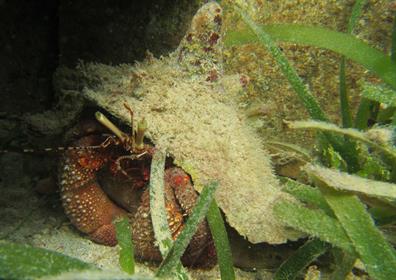



Petrochirus diogenes
Size
To 20cm.
Description:
Largest Antiguan Hermit Crab and older individuals can be found in fully grown shells of the Queen Conch (Lobatus gigas). Reddish grey to reddish brown. The claws are unequal (heterochely) but are closer in size compared to many other hermits, the right being slightly larger than the left. Texture resembeles overlapping scales. Red and white banded antennae. The claw arms (chelipeds) are reddish except between the fingers and usually feature white spots.
Some sexual dimorphism exists for the species with regard to size of adults, with males growing slightly larger than females. Maximum lengths reported for the anterior shield are 40 mm and 32 mm for males and females, respectively.. However, P. diogenes are found living inside of large gastropod shells and are equipped with prominent claws that substantially increase the total size of these crabs from the measurements mentioned above. Males not only grow larger but are also heavier than their female counterparts, with average total-body wet weights of approximately 95 g and 50 g for males and females.
Ecology
Inhabit sea grass beds and sand, from shallow water to depths of 125m. It will attack and eat a conch, thus obtaining a meal and a shell.
Life Cycle
It has been suggested that male giant hermits use their large claws for defense and in battles for territory and mates. P. diogenes reproduces via the transfer of a spermatophore from the male to the female. After fertilization is complete, the female clutches the eggs on her a abdomen during development. Hatched larvae enter the water column and pass through 5-6 zoeal stages and one glaucothoe before metamorphosing into juvenile crabs. The total duration for this planktonic cycle can range between about 31 to 84 days, depending on food availability and water temperature. Based on the absence of ovigerous (egg-bearing) females with anterior shields under 10 mm, it is believed that this is the transitional size from juvenile to adult females
To 20cm.
Description:
Largest Antiguan Hermit Crab and older individuals can be found in fully grown shells of the Queen Conch (Lobatus gigas). Reddish grey to reddish brown. The claws are unequal (heterochely) but are closer in size compared to many other hermits, the right being slightly larger than the left. Texture resembeles overlapping scales. Red and white banded antennae. The claw arms (chelipeds) are reddish except between the fingers and usually feature white spots.
Some sexual dimorphism exists for the species with regard to size of adults, with males growing slightly larger than females. Maximum lengths reported for the anterior shield are 40 mm and 32 mm for males and females, respectively.. However, P. diogenes are found living inside of large gastropod shells and are equipped with prominent claws that substantially increase the total size of these crabs from the measurements mentioned above. Males not only grow larger but are also heavier than their female counterparts, with average total-body wet weights of approximately 95 g and 50 g for males and females.
Ecology
Inhabit sea grass beds and sand, from shallow water to depths of 125m. It will attack and eat a conch, thus obtaining a meal and a shell.
Life Cycle
It has been suggested that male giant hermits use their large claws for defense and in battles for territory and mates. P. diogenes reproduces via the transfer of a spermatophore from the male to the female. After fertilization is complete, the female clutches the eggs on her a abdomen during development. Hatched larvae enter the water column and pass through 5-6 zoeal stages and one glaucothoe before metamorphosing into juvenile crabs. The total duration for this planktonic cycle can range between about 31 to 84 days, depending on food availability and water temperature. Based on the absence of ovigerous (egg-bearing) females with anterior shields under 10 mm, it is believed that this is the transitional size from juvenile to adult females

| Ecological Descriptors | ||||
| Habitat | Size (cm) | Diet | Behaviour | Sex |
| S | 20 | Mol, Sca | I | F |
Giant Hermit Crab

245



262
Giant Hermit Crab


